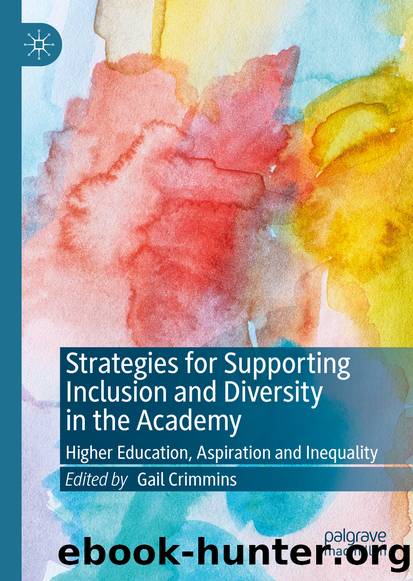Strategies for Supporting Inclusion and Diversity in the Academy by Unknown

Author:Unknown
Language: eng
Format: epub
ISBN: 9783030435936
Publisher: Springer International Publishing
LGBT Student Success
Academic and well-being outcomes for LGBT students vary in important ways from their cisgender, heterosexual peers. Some research has linked these differences directly to campus climate, while other studies provide broad descriptive findings showing these differences. Overall, the picture remains discouraging but there are some encouraging findings that suggest strategies for improving LGBT student outcomes.
Academic Experiences and Outcomes
Academic outcomes for LGBT students feature a paradox, with a number of factors at play. Evidence shows that LGBT students are more likely than non-LGBT peers to take time off from school (that is, to ‘stopout’) and to rate their academic performance lower (Garvey, Squire, Stachler, & Rankin, 2018; Greathouse et al., 2018; Mathies et al., 2019; Rankin et al., 2016). Yet they are also more likely under some conditions to engage in the kinds of activities called ‘high-impact practices’ that bring them into close relationship with faculty and peers, such as undergraduate research, study abroad, and service-learning—all of which are known to have a positive influence on student persistence (Greathouse et al., 2018; Kilgo, Linley, Renn, & Woodford, 2019).
The overall picture of academic outcomes for LGBT students is complex, in some areas more negative than it is for their non-LGBT peers and in some areas more positive. In a project that synthesized findings across four national surveys5 that were not specific to LGBT students, but which included sexual orientation and gender identity demographic questions, researchers were able to analyze data on over 66,000 LGBQ students and 6600 transgender students at 918 postsecondary institutions (Greathouse et al., 2018). They found that queer-spectrum and trans-spectrum students were more likely than their peers to skip class or go to class unprepared, to turn in an assignment late, or to fail one or more college courses. Twenty-eight percent of queer-spectrum students considered dropping out compared to 17% of heterosexual students, and 38% of trans-spectrum students considered dropping out compared to 18% of non-transgender students (Greathouse et al., 2018, pp. 16–17).
In some areas of academic engagement, however, LGBT students appear to thrive in comparison to their non-LGBT peers. As noted above, they may be more likely to engage in high-impact practices, and the student-faculty interaction that occurs through high-impact practices has a disproportionately positive effect on LGBQ and gender-variant students (BrckaLorenz, Garvey, Hurtado, & Latopolski, 2017; Garvey, BrckaLorenz, Latopolski, & Hurtado, 2018). They are more likely to contribute to a class discussion, take writing intensive courses, undertake research projects as part of coursework, and have academic experiences with a diversity focus (Greathouse et al., 2018). Faculty interactions in and out of class can provide a buffering effect against negative experiences in other aspects of LGBT students’ lives (Linley et al., 2016).
The concept of ‘micro-climates’ such as academic disciplines (Vaccaro, 2012) is helpful in understanding some differences among LGBT student experiences. Campus climate is not a monolith, and students may find more or less support in various micro-climates within an institution. Greathouse et al. (2018) reported that queer- and trans-spectrum students were disproportionately overrepresented in arts
Download
This site does not store any files on its server. We only index and link to content provided by other sites. Please contact the content providers to delete copyright contents if any and email us, we'll remove relevant links or contents immediately.
What's Done in Darkness by Kayla Perrin(25500)
Shot Through the Heart: DI Grace Fisher 2 by Isabelle Grey(18219)
Shot Through the Heart by Mercy Celeste(18160)
The Fifty Shades Trilogy & Grey by E L James(17774)
The 3rd Cycle of the Betrayed Series Collection: Extremely Controversial Historical Thrillers (Betrayed Series Boxed set) by McCray Carolyn(13189)
The Subtle Art of Not Giving a F*ck by Mark Manson(12912)
Scorched Earth by Nick Kyme(11832)
Stepbrother Stories 2 - 21 Taboo Story Collection (Brother Sister Stepbrother Stepsister Taboo Pseudo Incest Family Virgin Creampie Pregnant Forced Pregnancy Breeding) by Roxi Harding(11040)
Drei Generationen auf dem Jakobsweg by Stein Pia(10217)
Suna by Ziefle Pia(10186)
Scythe by Neal Shusterman(9259)
International Relations from the Global South; Worlds of Difference; First Edition by Arlene B. Tickner & Karen Smith(8608)
Successful Proposal Strategies for Small Businesses: Using Knowledge Management ot Win Govenment, Private Sector, and International Contracts 3rd Edition by Robert Frey(8419)
This is Going to Hurt by Adam Kay(7695)
Dirty Filthy Fix: A Fixed Trilogy Novella by Laurelin Paige(6453)
He Loves Me...KNOT by RC Boldt(5804)
How to Make Love to a Negro Without Getting Tired by Dany LaFerrière(5378)
Interdimensional Brothel by F4U(5304)
Thankful For Her by Alexa Riley(5161)
